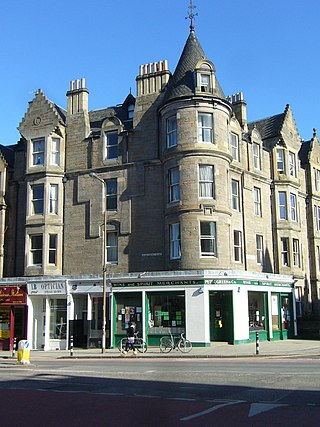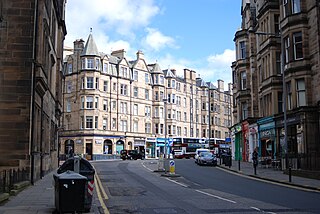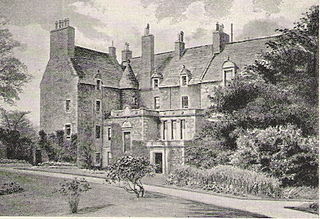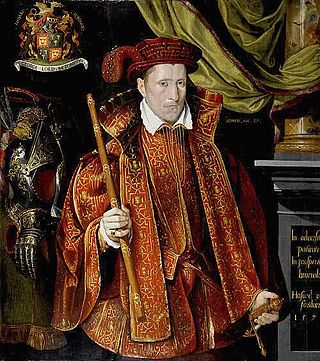Related Research Articles

The Battle of Solway Moss took place on Solway Moss near the River Esk on the English side of the Anglo-Scottish border in November 1542 between English and Scottish forces.

Marchmont is a mainly residential area of Edinburgh, Scotland. It lies roughly one mile to the south of the Old Town, separated from it by The Meadows and Bruntsfield Links. To the west it is bounded by Bruntsfield; to the south-southwest by Greenhill and then Morningside; to the south-southeast by The Grange; and to the east by Sciennes.

Bruntsfield is a largely residential area around Bruntsfield Place in Southern Edinburgh, Scotland. In feudal times, it fell within the barony of Colinton.

John Maitland, 1st Lord Maitland of Thirlestane, of Lethington, Knight (1581), was Lord Chancellor of Scotland.

Seton Palace was situated in East Lothian, a few miles south-east of Edinburgh near the town of Prestonpans. Often regarded as the most desirable Scottish residence of the sixteenth and seventeenth centuries, the palace was erected in the 15th century by George, 4th Lord Seton.

Sir George Warrender, 1st Baronet of Bruntsfield and Lochend, Edinburgh was a Scottish merchant and politician who sat in the House of Commons from 1715 to 1722.

George Seton V, 7th Lord Seton (1531–1586), was a Lord of the Parliament of Scotland, Master of the Household of Mary, Queen of Scots, and Provost of Edinburgh. He was the eldest son of George Seton, 6th Lord Seton, and Elizabeth Hay, a daughter of John Hay, 3rd Lord Hay of Yester. His childhood and schooling were in France.

Sir Peter Young (1544–1628) was a Scottish diplomat, Master Almoner, and tutor to James VI of Scotland.
Sir Richard Cockburn of Clerkington, Lord Clerkintoun (1565–1627) was a senior government official in Scotland serving as Lord Privy Seal of Scotland during the reign of James VI.
George Young was a Scottish churchman, courtier, member of the Privy Council of Scotland, diplomat, and secretary depute.

Claude de l'Isle de Marivaux was a French diplomat working for Henry of Navarre.
Sir William Keith of Delny was a Scottish courtier and Master of the Royal Wardrobe. He also served as ambassador for James VI to various countries. He was an important intermediary between George Keith, 5th Earl Marischal and the king, the king and courtiers, and the king and foreign governments.
Margaret Douglas, Countess of Bothwell was a Scottish aristocrat and courtier.
David Seton of Parbroath was a Scottish courtier and administrator.
Annie Isabella Cameron (1897–1973), later Annie Dunlop, was a Scottish historian.

Queen Elizabeth I of England paid a subsidy to King James VI of Scotland from 1586 to 1602. This enabled her to influence James by delaying or deferring payments to his diplomats in London. Records survive of the yearly amounts, and details of the expenditure in some years. A large proportion of the money was spent on the royal wardrobe of James and Anne of Denmark. Some royal expenses were met by Anne of Denmark's dowry, which was known as the "tocher". The regular incomes of the Scottish crown were feudal rents, customs, and "compositions" charged on grants of land. Accounts for royal incomes and payments survive as the exchequer rolls and lord treasurer's accounts and have been published as historical sources.

The Raid of Holyrood was an attack on Holyrood Palace, Edinburgh on 27 December 1591 by Francis Stewart, 5th Earl of Bothwell in order to gain the favour of King James VI of Scotland. Bothwell subsequently staged a raid at Falkland Palace, and in July 1593 made another attempt at Holyrood.
John Cockburn of Ormiston was a Scottish lawyer and landowner.
Margaret Wood was a Scottish Catholic courtier.
Alexander Stewart was a Scottish courtier and diplomat.
References
- ↑ History of the Berwickshire Naturalists' Club, 15 (1897), p. 36.
- ↑ M. W., Illustrations of Sixteenth Century Scottish History (Edinburgh, 1889), p. vi.
- ↑ Annie I. Cameron, Warrender Papers, (Edinburgh: SHS, 1931), p. viii.
- ↑ Warrender, Julian Margaret Maitland, 1912